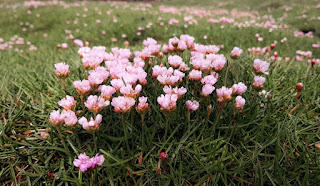 |
| Melancholy thistle Image: P Stroh |
Four of them are in the genus Cirsium: spear thistle C. vulgare; marsh thistle C. palustre; creeping thistle C. arvense and melancholy thistle C. heterophyllum.
The fifth is Carlina vulgaris, the carline thistle.
The so-called Scotch thistle Ornopodium acanthium - which looks most like the stylised thistle seen on modern coins - is an archaeophyte.
The Online Flora of the British Isles tells us that there is archaeological evidence for it in Britain from the Iron Age onwards but as this distribution map shows, it has a mostly southern distribution.
 |
| Spear thistle Image courtesy of Floral Images http://www.floralimages.co.uk/ page.php?taxon=cirsium_vulgare,1 |
For all that, the abundant and ubiquitous spear thistle is arguably a stronger candidate and looks more like the thistle seen on early coins.
While there may be disagreement about which thistle deserves to be the Scottish national symbol, it's 100% certain which thistle is found in Byron's Gin! Not only is the lovely melancholy thistle one of the ingredients, it actually gives its name to one of the two expressions of Byron's Gin.
But whichever of the two expressions you opt for - either Melancholy Thistle or Bird Cherry - you can be sure that for every bottle sold, a contribution goes towards BSBI's Training programme which helps support the next generation of botanists as they hone their ID skills.
























